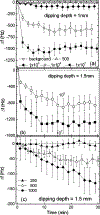In situ, in-liquid, all-electrical detection of Salmonella typhimurium using lead titanate zirconate/gold-coated glass cantilevers at any dipping depth
- PMID: 17387007
- PMCID: PMC6469510
- DOI: 10.1016/j.bios.2007.02.005
In situ, in-liquid, all-electrical detection of Salmonella typhimurium using lead titanate zirconate/gold-coated glass cantilevers at any dipping depth
Abstract
Most biosensing techniques are indirect, slow, and require labeling. Even though silicon-based microcantilever sensors are sensitive and label-free, they are not suitable for in-liquid detection. More recently lead zirconate titanate (PZT) thin-film-based microcantilevers are shown to be sensitive and in situ. However, they require microfabrication and must be electrically insulated. In this study, we show that highly sensitive, in situ, Salmonella typhimurium detection can be achieved at 90% relative humidity using a lead zirconate titanate (PZT)/gold-coated glass cantilever 0.7 mm long with a non-piezoelectric 2.7 mm long gold-coated glass tip by partially dipping the gold-coated glass tip in the suspension at any depth without electrically insulating the PZT. In particular, we showed that at 90% relative humidity and with a dipping depth larger than 0.8mm the PZT/gold-coated glass cantilever showed virtually no background resonance frequency up-shift due to water evaporation and exhibited a mass detection sensitivity of Deltam/Deltaf=-5 x 10(-11)g/Hz. The concentration sensitivities of this PZT/gold-coated glass cantilever were 1 x 10(3) and 500 cells/ml in 2 ml of liquid with a 1 and 1.5mm dipping depth, respectively, both more than two orders of magnitude lower than the infectious dose and more than one order of magnitude lower than the detection limit of a commercial Raptor sensor.
Figures






Similar articles
-
Real-Time, Label-Free, All-Electrical Detection of Salmonella typhimurium Using Lead Zirconate Titanate/Gold-Coated Glass Cantilevers at any Relative Humidity.Sens Actuators B Chem. 2007 Aug 8;125(2):379-388. doi: 10.1016/j.snb.2007.02.030. Sens Actuators B Chem. 2007. PMID: 22872784 Free PMC article.
-
Detection of pathogen Escherichia coli O157:H7 using self-excited PZT-glass microcantilevers.Biosens Bioelectron. 2005 Sep 15;21(3):462-73. doi: 10.1016/j.bios.2004.11.009. Epub 2004 Dec 21. Biosens Bioelectron. 2005. PMID: 16076436
-
Escherichia coli O157:H7 detection limit of millimeter-sized PZT cantilever sensors is 700 cells/mL.Anal Sci. 2005 Apr;21(4):355-7. doi: 10.2116/analsci.21.355. Anal Sci. 2005. PMID: 15844324
-
Torsional and lateral resonant modes of cantilevers as biosensors: alternatives to bending modes.Anal Chem. 2013 Feb 5;85(3):1760-6. doi: 10.1021/ac303092q. Epub 2013 Jan 10. Anal Chem. 2013. PMID: 23276186
-
Label free novel electrical detection using micromachined PZT monolithic thin film cantilever for the detection of C-reactive protein.Biosens Bioelectron. 2004 Sep 15;20(2):269-75. doi: 10.1016/j.bios.2004.01.024. Biosens Bioelectron. 2004. PMID: 15308231
Cited by
-
Real-Time, Label-Free, All-Electrical Detection of Salmonella typhimurium Using Lead Zirconate Titanate/Gold-Coated Glass Cantilevers at any Relative Humidity.Sens Actuators B Chem. 2007 Aug 8;125(2):379-388. doi: 10.1016/j.snb.2007.02.030. Sens Actuators B Chem. 2007. PMID: 22872784 Free PMC article.
-
Enhanced Detection Resonance Frequency Shift of a Piezoelectric Microcantilever Sensor by a DC Bias Electric Field in Humidity Detection.Sens Actuators B Chem. 2009 Apr 24;138(1):1-4. doi: 10.1016/j.snb.2009.01.035. Sens Actuators B Chem. 2009. PMID: 20161253 Free PMC article.
-
A rapid method to regenerate piezoelectric microcantilever sensors (PEMS).Sensors (Basel). 2011;11(5):5520-8. doi: 10.3390/s110505520. Sensors (Basel). 2011. PMID: 22413149 Free PMC article.
-
Biomimetic strategies for sensing biological species.Biosensors (Basel). 2013 Feb 6;3(1):89-107. doi: 10.3390/bios3010089. eCollection 2013 Mar. Biosensors (Basel). 2013. PMID: 25587400 Free PMC article. Review.
-
Mechanism of flexural resonance frequency shift of a piezoelectric microcantilever sensor during humidity detection.Appl Phys Lett. 2008 May 5;92(18):183505-1835053. doi: 10.1063/1.2921050. Epub 2008 May 9. Appl Phys Lett. 2008. PMID: 19479043 Free PMC article.
References
-
- Baselt DR, Lee GU, Colton RJ, 1996. J. Vac. Sci. Technol. B 14 (2), 789–793.
-
- Buttry DA, Ward MD, 1992. Chem. Rev 92, 1355–1379.
-
- Call DR, Brockman FJ, Chandler DP, 2001. Int. J. Food Microbiol 67 (1–2), 71–80. - PubMed
-
- Campbell GA, Mutharasan R, 2005a. Sens. Actuators A: Phys. 122 (2), 326–334.
Publication types
MeSH terms
Substances
Grants and funding
LinkOut - more resources
Full Text Sources
Other Literature Sources

